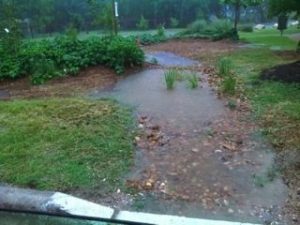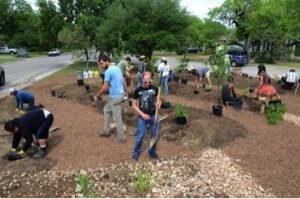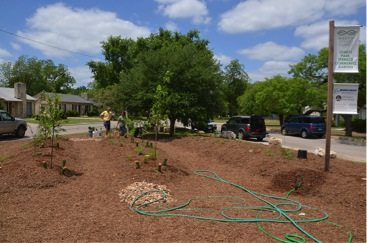It’s no secret that Texas is still enduring a significant drought as we head into 2015. “Drought restrictions” and “watering days” are common lingo among San Antonio residents as many of us attempt to conserve our precious water. In 2011, drought monitor maps glowed bright red with the bulk of the state in either exceptional or extreme drought. For San Antonio area community gardeners, drought was evident as they tried to nurture crops through the summer of 2011. Not only were the annual crops at gardens failing to thrive, the drought was palpable by the sound of crunching grass and dry topsoil under gardeners’ feet. Rainwater collection efforts at area gardens fell short since harvested rainwater was quickly used and slowly replenished. San Antonio’s average annual rainfall is 32.9 inches which is not far off from Seattle’s 36.2, a city known for its abundant rain. Certainly, San Antonio experiences more sun and higher temperatures than Seattle so a blanket comparison is less than fair. Another challenge is San Antonio’s rain patterns, which tend toward long periods without rain followed by a relative deluge that urban residents are encouraged to move quickly off the land and into stormwater drains. Current drought monitor maps show that conditions are improving in much of Texas to include San Antonio. Historically, Texas is no stranger to drought. Extreme drought conditions could always be on the horizon. 
Wisely, area gardeners are seeking ways to capitalize on the rainfall through design techniques like those gleaned from Permaculture Design and Low Impact Development. In San Antonio, strong grassroots efforts are being made to bring permaculture design principles and techniques into the spotlight as a way to address the need to re-invent how we experience water in the landscape. One such effort was the food forest project at Olmos Park Terrace (OPT) Community Garden. In May of 2014, OPT garden members led the charge to transform a traffic triangle park into a lush, water-wise food forest. Green Spaces Alliance (GSA) Community Gardens Program along with forces from the San Antonio Permaculture Group and the Austin Permaculture Guild assisted gardeners in the dramatic transformation. After attending a GSA sponsored workshop on Permaculture Design in the fall of 2011, the height of the local drought, OPT gardeners became inspired to swap their 4 x 4 raised beds with berms and bioswales planted with perennial food crops and native pollinator plants. They recognized the water flow patterns on the streets flanking the triangle park and noticed that during significant rainstorms water ran into the curb, around the garden and into the stormwater drain three blocks away. As budding permaculture designers they realized that this was a prime example of the problem being the solution. A simple curb cut would allow water into the garden consequently feeding the food forest’s bioswales.
 Since the successful implementation of this project, similar projects at other community gardens are planned for 2015. Luckily, area organizations, like San Antonio River Authority whose work supports water quality and the health of San Antonio River watersheds, are strongly supporting the use of raingardens and other Low Impact Development design techniques. With more examples of small-scale neighborhood projects like OPT, a few adjustments to policies on curb cuts, in concert with greater backing from more and more local organizations and engineering firms that effect large scale projects, perhaps drought will begin to impact San Antonio less dramatically in years to come.
Since the successful implementation of this project, similar projects at other community gardens are planned for 2015. Luckily, area organizations, like San Antonio River Authority whose work supports water quality and the health of San Antonio River watersheds, are strongly supporting the use of raingardens and other Low Impact Development design techniques. With more examples of small-scale neighborhood projects like OPT, a few adjustments to policies on curb cuts, in concert with greater backing from more and more local organizations and engineering firms that effect large scale projects, perhaps drought will begin to impact San Antonio less dramatically in years to come.
From time to time, Water – Use It Wisely features guest bloggers who write about topics related to water and water conservation. Michelle Gorham is a horticulturist who currently grows gardeners as the Assistant Community Gardens Program Manager at Green Spaces Alliance of South Texas. She lives with her husband, daughter, and many four-legged creatures on 4 lovely acres along the San Antonio River that are just begging to be re-invigorated.
Additional information:
http://www.saws.org/conservation/droughtrestrictions/StageTwo.cfm
http://www.usclimatedata.com/climate/san-antonio/texas/united-states/ustx1200
http://www.lowimpactdevelopment.org/
https://www.nrdc.org/experts/thinking-outside-pipe


